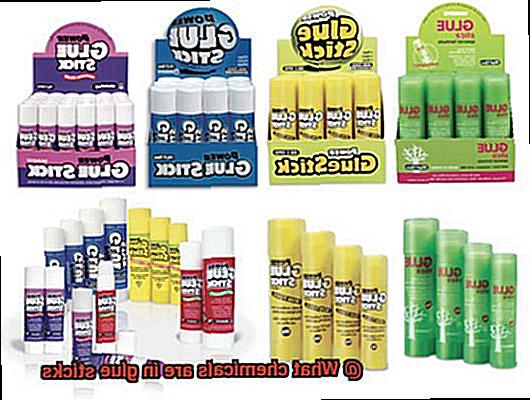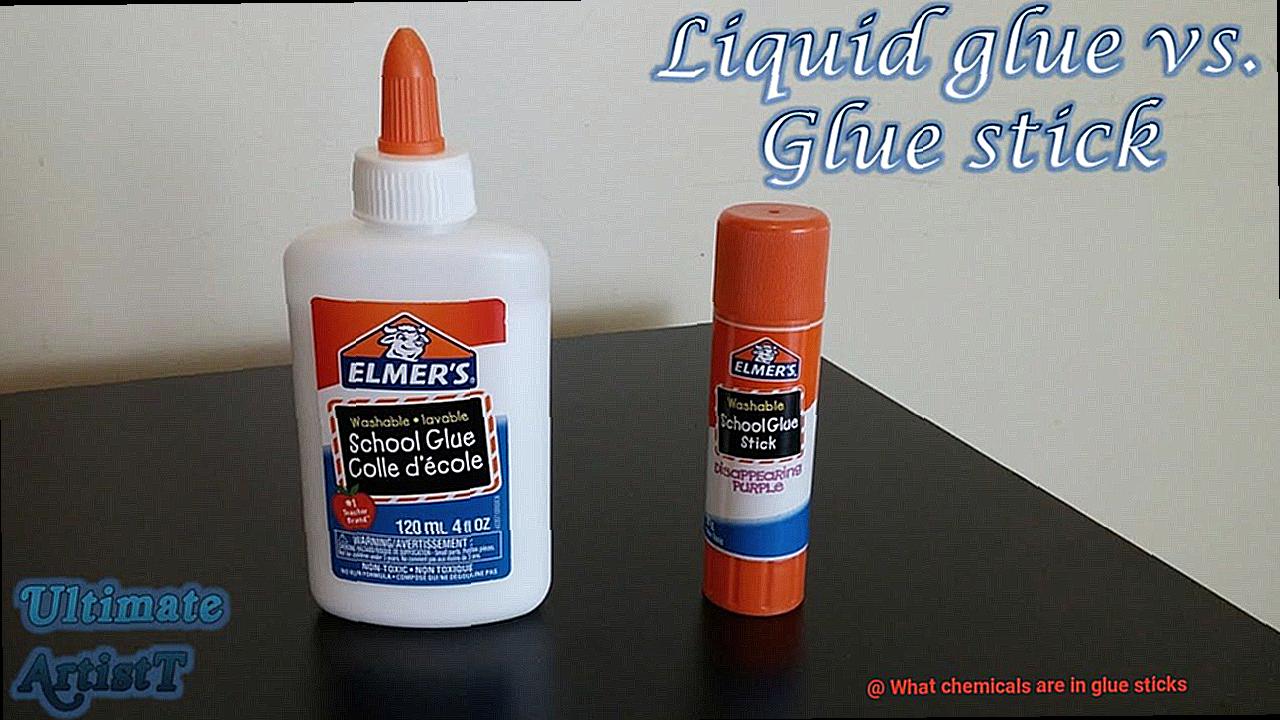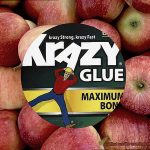Ever wondered what makes glue sticks so darn sticky? If you’re anything like me, you’ve probably found yourself peeling back layers of curiosity, desperate to uncover the secret behind their adhesive sorcery. Well, fear not. Today, we’re diving deep into the world of chemistry to reveal the hidden chemicals that give these humble sticks their stickiness.
Glue sticks aren’t just conjured up by magic alone. Oh no. Their stickiness is a result of a carefully crafted concoction of chemicals that have been handpicked for their adhesive superpowers. Understanding these components will shed some light on why glue sticks are so darn good at sticking stuff together.
- Polyvinyl acetate (PVA): This here is the star of our show – the primary adhesive component in most glue sticks. PVA is a clear, rubbery liquid that doesn’t have any funky smells. But here’s where things get interesting: when it dries, it becomes solid and forms a strong bond by interlocking with the molecules on whatever surface it’s applied to. It’s like a molecular handshake. Plus, PVA plays well with others – it works its magic on all sorts of materials like paper, cardboard, and fabric.
- Tackifiers: These sneaky substances are added to glue sticks to boost their adhesion powers and make sure they stick right away after application. They create a stronger initial bond before our trusty PVA fully cures. Some tackifiers even bring along pleasant scents, giving certain glue sticks that extra oomph.
- Plasticizers: To keep our glue sticks flexible and durable over time, we introduce plasticizers into the mix. These clever chemicals help maintain those adhesive qualities even after multiple uses. They also prevent our beloved glue from becoming too brittle and prone to cracks or breakages.
- Humectants: Nobody likes a dried-up glue stick, right? That’s why we throw in humectants to keep things nice and moist. These moisture-loving substances ensure a smooth and consistent application every time. Think of them as the glue stick’s hydration squad – glycerin and sorbitol are their star players.
- Antioxidants: We all want our glue sticks to last longer, don’t we? That’s where antioxidants come in. They swoop in to save the day by slowing down the aging process and preventing our precious PVA from going bad. Thanks, antioxidants.
Primary Chemical Found in Glue Sticks: Polyvinyl Acetate (PVA)
Contents
- 1 Primary Chemical Found in Glue Sticks: Polyvinyl Acetate (PVA)
- 2 Role of Water in Glue Sticks
- 3 Enhancing Adhesive Properties with Additives
- 4 The Use of Preservatives in Glue Sticks
- 5 Colorants and Visual Appeal of Glue Sticks
- 6 Variations between Brands and Formulations
- 7 Safety Considerations when Using Glue Sticks
- 8 Conclusion
Glue sticks, those unassuming heroes of the crafting world, possess a secret ingredient that makes them so magical. It’s called Polyvinyl Acetate (PVA) – the primary chemical found within these humble sticks of adhesive.
In this article, we will embark on a journey into the captivating world of PVA, exploring its unique characteristics, composition, and wide-ranging applications in adhesives and beyond. Prepare to be amazed as we unveil the secrets of PVA and discover why it reigns supreme as the superhero of all glues.
Characteristics of PVA:
Polyvinyl Acetate (PVA) is a thermoplastic polymer that is specially formulated for use in glue sticks. This synthetic wonder is created by polymerizing vinyl acetate monomers, resulting in a white, odorless, and non-toxic substance that is safe for general use. But don’t let its unassuming appearance fool you – PVA boasts remarkable adhesive properties that make it ideal for bonding a wide range of materials, including paper, cardboard, fabric, and wood.
Composition and Structure:
At its core, PVA consists of long chains formed by repeating vinyl acetate units. These chains serve as the backbone of PVA’s unique structure, enabling it to create strong bonds when it dries. When in its liquid state, PVA flows effortlessly and spreads smoothly onto surfaces. However, as it dries, these chains intertwine to form a flexible and durable bond that securely holds materials together.
Versatile Applications in Adhesives:
PVA glue sticks have become a staple in school projects, arts and crafts endeavors, and general household repairs. Crafters of all ages are drawn to these versatile adhesives due to their user-friendly nature and mess-free application. Whether you’re working on a scrapbooking project or repairing a torn page, PVA glue sticks offer a reliable and precise solution, ensuring your creations stay together with ease.
Advantages of PVA:
- Ease of Use: PVA glue sticks provide precise application without the hassle of drips or spills, making them a breeze to work with.
- Quick Drying: With PVA, time is on your side. Its rapid drying properties save time and minimize the risk of smudging or shifting materials during the bonding process.
- Clean Application: Bid farewell to messy mishaps. PVA glue sticks leave behind minimal residue, guaranteeing a neat and professional finish to your projects.
- Water-Soluble: PVA’s water-soluble nature makes cleanup a breeze. Excess glue can be easily wiped away with just a damp cloth or sponge.
- Versatility: PVA is the master of all trades when it comes to bonding materials, making it suitable for an array of projects and applications.
Disadvantages of PVA:
- Limited Strength: While PVA excels in most everyday applications, it may not be the optimal choice for heavy-duty or load-bearing tasks that require maximum strength.
- Susceptible to Moisture: As PVA is water-soluble, it may not be the ideal option for projects that demand resistance to moisture or humidity.
Beyond Glue Sticks:
PVA’s prowess extends far beyond the realm of glue sticks, finding its way into other adhesive products such as wood glue and wallpaper paste. Its versatility has even led to applications in construction, packaging, and textiles, further solidifying its reputation as a go-to adhesive powerhouse.
Role of Water in Glue Sticks
Prepare to be amazed by the extraordinary powers of glue sticks. Behind their seemingly simple exterior lies the secret ingredient that transforms them into formidable adhesives – water. Yes, that’s right. Water plays a pivotal role in turning ordinary glue sticks into superheroes capable of bonding almost anything together. Join us as we dive into the captivating world of glue sticks and uncover the remarkable role water plays in their incredible stickiness.
Water as a Carrier:
Water acts as a trusty sidekick, serving as a carrier for the main ingredient in glue sticks – polyvinyl acetate (PVA) polymer. This water-based adhesive comes alive when it encounters moisture. When you glide the glue stick across a surface, water helps evenly distribute the PVA, making it effortlessly easy to use.
Drying and Setting:
Once applied, the water content in the glue stick embarks on a vanishing act, evaporating into thin air. As this magical disappearance occurs, the PVA solidifies and locks your project in place, creating a bond that is unbreakable. So, whether you’re attaching googly eyes or affixing paper cut-outs, remember that it’s the water that’s conjuring up this mesmerizing display.
Regulating Viscosity:
Water also possesses the power to regulate viscosity, granting glue sticks their smooth and silky consistency. It ensures that the adhesive glides effortlessly across surfaces, bestowing upon it an enchanting user-friendly quality suitable for both young creators and seasoned crafters. Bid adieu to gloopy messes or runny mishaps.
Solvent for Additives:
In addition to PVA, glue sticks may contain a host of other additives such as preservatives, thickeners, colorants, and performance enhancers. Like an alchemist’s potion, water acts as a solvent, effortlessly dissolving these additives and blending them seamlessly with the PVA. This harmonious fusion ensures that your glue stick performs at its best while maintaining its safe and non-toxic nature.

Safe and Non-Toxic:
Unlike their solvent-based counterparts that release noxious fumes, glue sticks are the epitome of safety. Thanks to the water content, you can unleash your creativity in enclosed spaces without any health risks. It’s a sigh of relief for parents and a breath of fresh air for creators alike.
Enhancing Adhesive Properties with Additives
Enhancing adhesive properties with additives is like giving your glue stick a superhero upgrade. These magical substances work together to take your crafting and repair projects to new heights. So, let’s dive into the world of glue sticks and explore the incredible benefits of additives.
First on our list are the secret agents of glue sticks: tackifiers. These little wonders increase the stickiness or tack of the glue, ensuring a strong bond that won’t let you down. Whether you’re delicately assembling an art project or fixing a broken household item, tackifiers will be your trusty sidekick.
Next up, we have the ever-reliable plasticizers. Picture this: you’ve glued something together, but over time, it becomes brittle and cracks. Not ideal, right? Well, fear not. Plasticizers are here to save the day. They increase the flexibility and durability of the glue, preventing it from becoming brittle and ensuring a long-lasting bond.
But wait, there’s more. Fillers add volume and bulk to the adhesive without compromising its adhesive properties. This means your glue will flow smoothly and spread evenly, giving your projects a professional finish.
Let’s not forget about antioxidants and preservatives. These additives protect your glue stick from deterioration caused by oxygen or heat exposure. No one wants their glue to lose its superpowers, right? Antioxidants and preservatives keep your glue fresh and ready for any bonding challenge that comes its way.
Last but not least, thickeners control the viscosity of the adhesive. They ensure your glue is just the right consistency for your project, whether you need a thin layer for delicate crafts or a thick layer for heavy-duty repairs.
Before we wrap up, it’s important to note that while additives enhance adhesive properties, they may introduce risks or limitations. Always read product labels and follow instructions for safe and effective use.
The Use of Preservatives in Glue Sticks
Preservatives are an essential ingredient in glue sticks, working behind the scenes to maintain their quality and safety. Glue sticks are often exposed to air and moisture, creating the perfect environment for bacteria, fungi, and mold to grow. Nobody wants to use a moldy or bacteria-infested glue stick, right? That’s where preservatives come in.
One superhero preservative commonly used in glue sticks is benzisothiazolinone (BIT). This biocide has the power to inhibit the growth and reproduction of bacteria and fungi. It keeps those pesky microorganisms at bay, ensuring that your glue stick remains fresh and effective.
Another powerful preservative in the world of glue sticks is methylisothiazolinone (MIT). Just like BIT, MIT stops the growth of bacteria, fungi, and mold. It’s often used alongside other preservatives to provide broad-spectrum protection. Rest assured, MIT has been extensively tested for safety and is approved for use in various consumer products, including glue sticks.
Glue stick manufacturers may also use other preservatives such as iodopropynyl butylcarbamate (IPBC) or formaldehyde-releasing agents. These preservatives have antimicrobial properties and help prolong the shelf life of glue sticks. However, due to concerns about potential health effects, the use of formaldehyde-releasing agents in glue sticks has become less common.
It’s important to note that while preservatives are crucial for preventing microbial growth in glue sticks, their use should be carefully regulated. Manufacturers must ensure that the concentration of preservatives used is within safe limits and complies with regulatory guidelines. This ensures that glue sticks remain safe for consumer use.
If you have any concerns or known allergies, make sure to read the product label or consult with a healthcare professional. And remember, proper storage and handling of glue sticks can also help maintain their quality and prevent contamination.
Colorants and Visual Appeal of Glue Sticks
Glue sticks, those trusty companions in the world of crafts and office work, have a secret weapon that adds a dash of visual appeal to their reliable functionality. Enter colorants. These magical additives transform ordinary glue sticks into vibrant works of art, making them not only practical but visually stunning too. So, let’s unravel the enchanting world of colorants and discover how they give glue sticks their captivating charm.
To start our journey, let’s explore the different types of colorants that grace these humble sticks. Pigments and dyes reign supreme in the realm of colorants. Pigments are insoluble particles that infuse glue sticks with rich hues. Derived from natural or synthetic sources, these tiny particles are mixed into the glue’s formulation during manufacturing. On the flip side, dyes are soluble substances that dissolve within the glue, producing transparent or translucent finishes.
Now, brace yourself for an explosion of colors. Glue sticks can don a kaleidoscope of hues thanks to these colorants. Think titanium dioxide for pure white, carbon black for deep blacks, iron oxides for fiery reds, sunny yellows, and earthy browns, and ultramarine blue for a touch of serene sky. But wait, there’s more. Dyes open up a whole new world of possibilities with an array of vibrant colors like fiery reds, tranquil blues, lush greens, and sunny yellows.
But why does visual appeal matter when it comes to glue sticks? Aside from adding pizzazz to your craft projects, colorants also serve a practical purpose. Different colors can help you swiftly identify specific types or brands of glue sticks amidst your collection. No more fumbling around in search of the perfect adhesive—your colorful glue stick will be right at your fingertips.
Before we end our colorful adventure, it’s worth noting that the concentration of colorants in glue sticks is typically low. Rest assured, this means they pose no significant health risks when used as intended. So go ahead, revel in the visual splendor of your glue stick without any concerns.
Variations between Brands and Formulations

The variations between brands and formulations of glue sticks are fascinating and can greatly impact their performance and characteristics. Let’s dive into the world of glue variations and discover what sets them apart.
At the heart of every glue stick lies its main ingredient – polymers. Most glue sticks utilize a polymer known as polyvinyl acetate (PVA) to provide adhesive properties. However, the exciting part is that different brands may employ various types of polymers or unique variations of PVA, resulting in distinct performance differences.
Some brands go the extra mile by enhancing their glue sticks with additional chemicals like solvents or plasticizers. These additives can improve adhesion or flexibility, making each glue stick unique in its own way. As a result, not all glue sticks are created equal – some may possess superior strength, faster drying times, or greater flexibility than others.
In fact, certain brands even offer specialized formulations tailored for specific applications. Need a high-strength adhesive for heavy-duty projects? There’s a glue stick designed just for that purpose. Craving a fast-drying solution for those moments of impatience? You betcha, there’s a glue stick formulated to meet that need too.
However, it’s crucial to consider safety before you start sticking everything together. The chemical composition of glue sticks can differ between brands and formulations, impacting safety and environmental considerations. Certain formulations might contain harmful chemicals or volatile organic compounds (VOCs). Therefore, it’s always wise to read labels and exercise caution when working with specific glue sticks.
So whether you’re an artsy crafter or an office wizard, understanding the distinctions between brands and formulations of glue sticks is essential for successful projects. Take into account factors such as strength, drying time, and safety when selecting the most suitable glue stick for your needs.
Safety Considerations when Using Glue Sticks
Glue sticks are a convenient and mess-free way to bond materials together, but it’s important to remember that they contain chemicals that require proper handling. In this article, we will explore the safety considerations when using glue sticks and provide tips to ensure a safe and enjoyable experience.
Be Mindful of Chemicals:
- Polyvinyl acetate (PVA): PVA is the main ingredient in glue sticks and is generally safe for use. However, prolonged exposure or ingestion can cause mild irritation. Avoid direct contact with PVA and wash hands thoroughly after use.
- Ethylene vinyl acetate (EVA): EVA enhances the flexibility and bonding strength of glue sticks. While it’s generally safe, inhaling fumes can lead to respiratory irritation. Work in a well-ventilated area or use a respiratory mask for extended use.
Check for Additives:

- Preservatives and colorants: Some glue sticks may contain additional chemicals to extend shelf life or enhance appearance. Individuals with allergies or sensitivities should check the ingredient list before use.
Keep Glue Sticks Away from Children:
- Glue sticks may be mistaken for food or play items by children. While most are non-toxic, ingestion can lead to gastrointestinal issues. Store glue sticks securely out of reach of young children.
Accidental Exposure:
- In case of accidental ingestion or exposure to large amounts of adhesive, seek medical advice immediately. Provide detailed information about the glue stick brand and ingredients to assist in proper treatment.
Proper Ventilation and Skin Contact:
- Work in a well-ventilated area to minimize inhalation of fumes.
- If adhesive comes into contact with eyes, rinse with water and seek medical attention if irritation persists.
- For skin contact, wash the affected area with soap and water.
Also Read: What are Glue Sticks Made of? – Glue Things
Conclusion
In conclusion, glue sticks contain a variety of chemicals that work together to create their adhesive properties.
These chemicals include polyvinyl acetate, which is the main ingredient in most glue sticks and provides the stickiness that allows them to bond materials. Other chemicals commonly found in glue sticks include water, which acts as a solvent and helps the glue spread smoothly, and various additives such as thickeners and preservatives.
It’s important to note that while these chemicals are generally safe for use, it’s always advisable to follow proper safety precautions when handling glue sticks, such as avoiding contact with eyes or ingestion.






